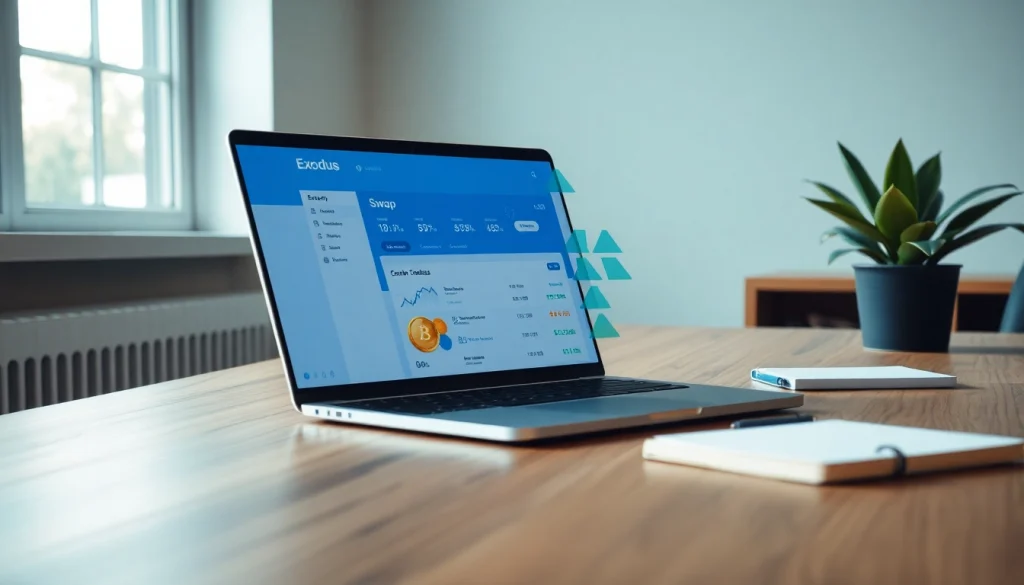What is the Exodus Wallet?
The exodus wallet is a popular, user-friendly cryptocurrency wallet that allows users to securely manage their digital assets. Launched in 2016, Exodus has gained acclaim for its intuitive design, ease of use, and robust security features. This wallet supports a wide array of cryptocurrencies, making it an ideal choice for both novice and experienced crypto enthusiasts seeking to store, send, receive, and exchange digital currencies.
Overview of Exodus Wallet Features
The Exodus wallet is packed with features designed to enhance the user experience. Its key functionalities include:
- Multi-Currency Support: Exodus supports over 100 cryptocurrencies, including Bitcoin, Ethereum, and Litecoin, which allows users to manage diverse portfolios within a single application.
- User-Friendly Interface: The wallet’s interface is simple and intuitive, which is particularly helpful for beginners who may be intimidated by other more complex wallets.
- Integrated Exchange: Users can easily trade cryptocurrencies through the built-in exchange feature without needing to use external platforms.
- Portfolio Tracking: Exodus provides detailed asset tracking, allowing users to view their portfolio performance and make informed investment decisions.
- Cross-Platform Availability: The Exodus wallet is available on multiple platforms, including desktop (Windows, macOS, Linux) and mobile (iOS, Android), ensuring accessibility from anywhere.
- Security Features: Exodus employs industry-standard security protocols, including encrypted private keys and backup functionality, ensuring that users have control over their funds.
How Exodus Wallet Works
At its core, the Exodus wallet functions as a software wallet designed to store users’ private keys directly on their devices. Unlike custodial wallets, where a third party manages the keys, Exodus empowers users with complete control over their private keys. Here’s a breakdown of how it operates:
- Setup: Users can easily download and install the wallet on their device. During the setup process, a recovery phrase is generated, which is crucial for restoring access to the wallet in case of device loss.
- Storing Assets: Users can receive cryptocurrencies by generating unique wallet addresses for each asset. These addresses are used to send crypto into their Exodus wallet.
- Sending and Receiving Cryptocurrencies: Transactions are conducted seamlessly. Users simply enter the recipient’s address, select the amount, and confirm the transaction. The integrated exchange also allows users to swap assets with minimal hassle.
- Backup and Recovery: Exodus prompts users to back up their wallet upon initial setup. This backup feature is essential for recovering funds if the wallet is lost or the device is compromised.
Different Types of Cryptocurrencies Supported
Exodus supports a wide variety of cryptocurrencies, making it appealing to a broad audience. Currently, the wallet allows for the management of over 100 cryptocurrencies, which include:
- Bitcoin (BTC)
- Ethereum (ETH)
- Litecoin (LTC)
- XRP (Ripple)
- Bitcoin Cash (BCH)
- Dash (DASH)
- Chainlink (LINK)
- Stellar Lumens (XLM)
- Dogecoin (DOGE)
- Cardano (ADA)
- Polkadot (DOT)
- ERC-20 Tokens: Exodus also supports a variety of ERC-20 tokens, which are built on the Ethereum blockchain.
Benefits of Using the Exodus Wallet
The Exodus wallet presents numerous advantages that cater to different user needs. Understanding these benefits is vital for potential users weighing their options in the competitive landscape of cryptocurrency wallets.
User Experience and Interface Highlights
The design of Exodus emphasizes a positive user experience. Key highlights include:
- Visual Design: The wallet features a visually appealing interface, showcasing asset values in real-time, accompanied by graphical representations of portfolio diversity.
- Intuitive Navigation: Users can easily access different wallet functionalities such as sending, receiving, and exchanging cryptocurrencies through straightforward navigation menus.
- Onboarding Process: A guided onboarding process introduces new users to wallet functionalities, ensuring they feel confident and informed immediately upon install.
Security Features of the Exodus Wallet
Security is crucial in the crypto sphere, and Exodus provides a robust set of security features:
- Client-Side Encryption: Private keys and transaction data are encrypted on the user’s device to minimize the risk of unauthorized access.
- Backup and Recovery: Exodus encourages users to back up their recovery phrase, making it easier to recover access in case their device is lost.
- No Registration Required: Users can maintain anonymity since no personal information is required for wallet creation, reducing the risk of data breaches.
How Exodus Stands Against Competitors
When compared to other wallets like Coinbase, Trezor, or Ledger, Exodus offers distinct advantages:
- User-Friendly: While many competitors may present a more complex interface, Exodus’s ease of use appeals to beginners, making it a favorable option for those new to cryptocurrencies.
- Integrated Services: The built-in exchange and portfolio tracking features differentiate it from wallets that require users to leave the platform to manage their portfolios.
- Volatile Asset Support: Unlike hardware wallets that typically support fewer assets, Exodus allows for easy management of a wide range of cryptocurrencies, which is critical for active traders.
Setting Up Your Exodus Wallet
Creating an Exodus wallet is a straightforward process. Below is a step-by-step guide detailing the setup procedure to help users get started quickly.
Step-by-Step Wallet Creation Process
Follow these steps to set up your Exodus wallet:
- Download the Wallet: Visit the official Exodus website or authorized app stores to download the wallet for your chosen platform.
- Install the Wallet: Simply follow the installation prompts to install the wallet application on your device.
- Create Your Wallet: Upon launching the application, select the option to create a new wallet. Exodus will generate a unique wallet address for you.
- Backup Your Recovery Phrase: Shortly after creating your wallet, you will receive a recovery phrase. Write it down and store it safely as it is your only means of recovering your wallet in case of loss.
- Personalize Your Wallet: Add your favorite assets, and customize settings, such as dark mode if preferred.
Connecting to Exchanges and Services
Exodus allows for seamless connectivity with various exchanges and services to facilitate transactions:
- Built-in Exchange: Users can connect to built-in exchanges like ShapeShift and Changelly, simplifying the process of trading between different cryptocurrencies directly from the wallet.
- Buying Crypto: With smart integrations, users can purchase cryptocurrencies using fiat currency. This can often be done using debit cards or bank transfers through partnerships with payment processors.
First-Time User Tips for Exodus Wallet
For those setting up the Exodus wallet for the first time, consider these practical tips:
- Always Backup: Immediately backup your recovery phrase and keep it in a secure place. It’s crucial for recovering your wallet.
- Explore Wallet Features: Take some time to explore the wallet’s features. Familiarize yourself with the interface to ensure a smooth experience.
- Enable Security Measures: Use any additional security features provided by Exodus, like setting up a password or enabling biometric recognition where supported.
Advanced Features of Exodus Wallet
Exodus has advanced functionalities that seasoned users can leverage for enhanced cryptocurrency management and trading.
Using the Built-in Exchange Feature
The built-in exchange is one of Exodus’s most compelling features. Here’s how users can maximize this tool:
- Access the Exchange: Navigate to the “Exchange” tab in the wallet, where users can see available trading pairs.
- Select Assets: Choose the cryptocurrency to swap from and the one to swap to. The system automatically calculates conversion rates based on current market prices.
- Complete the Transaction: Review the exchange fees before confirming the transaction. Once confirmed, the asset swap is processed, and users receive their new cryptocurrency immediately.
Utilizing the Exodus Wallet for Passive Income
Exodus offers avenues for earning passive income through various features:
- Staking: Users can stake certain coins directly from their Exodus wallet, enabling them to earn rewards just by holding specific cryptocurrencies.
- Earn Rewards: Through partnership arrangements with various projects, users can earn rewards for participating in ecosystem initiatives.
Integrating with Hardware Wallets for Extra Security
For users seeking enhanced security, Exodus allows integration with hardware wallets:
- Select Hardware Wallet: Exodus supports several hardware wallets, such as Trezor, offering an additional layer of security.
- Connect to Exodus: Follow the provided instructions to link your hardware wallet with Exodus, enabling users to manage their assets from a single interface.
- Access Security Features: Continue using the hardware wallet’s security benefits, including offline storage and PIN protection, which safeguard against unauthorized access.
Common Challenges and Solutions with Exodus Wallet
Every user might encounter challenges while using the Exodus wallet. It’s important to address common issues proactively to enhance user experience.
Addressing Security Concerns and Vulnerabilities
Security is a primary concern for crypto wallet users. Consider the following solutions:
- Stay Updated: Regularly update the Exodus wallet to ensure you have the latest security patches and features.
- Be Aware of Phishing Scams: Use only official links for accessing your wallet and never share private keys or recovery phrases.
Understanding Transaction Fees in Exodus Wallet
Transaction fees can vary, depending on network congestion and the type of asset being moved. Here’s how to manage them:
- Monitor Fees: Users can review estimated fees before confirming transactions to avoid unnecessary costs.
- Timing Transactions: For less urgent transactions, consider timing them during periods of lower network activity to minimize fees.
Finding Support and Resources for Exodus Users
Accessing support can enhance the user experience significantly. Here are suggested resources:
- Official Help Center: The Exodus help center offers numerous articles and FAQs covering common issues and queries.
- Community Forums: Engaging with community forums or platforms like Reddit can provide user experiences and solutions for specific challenges.


